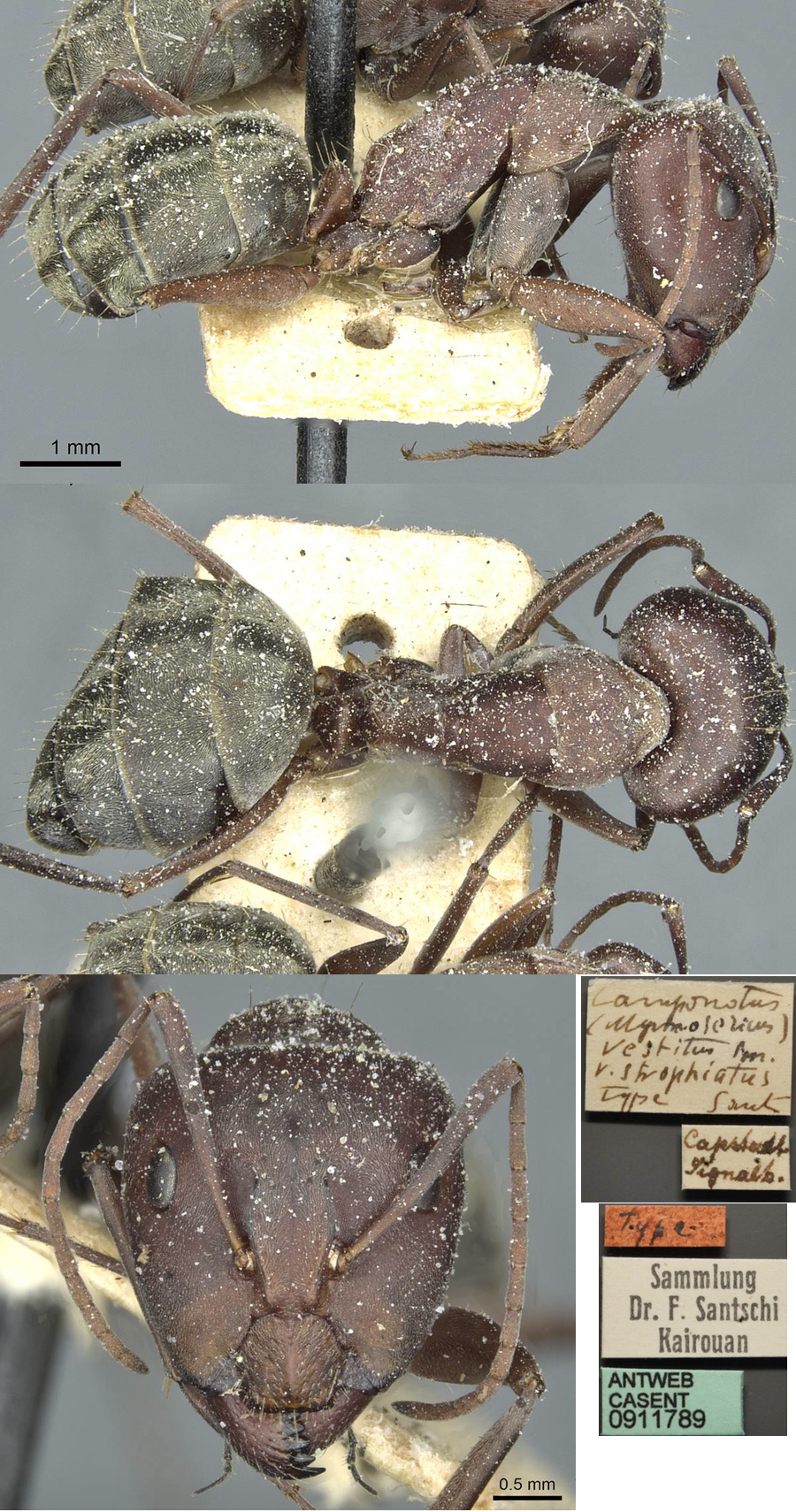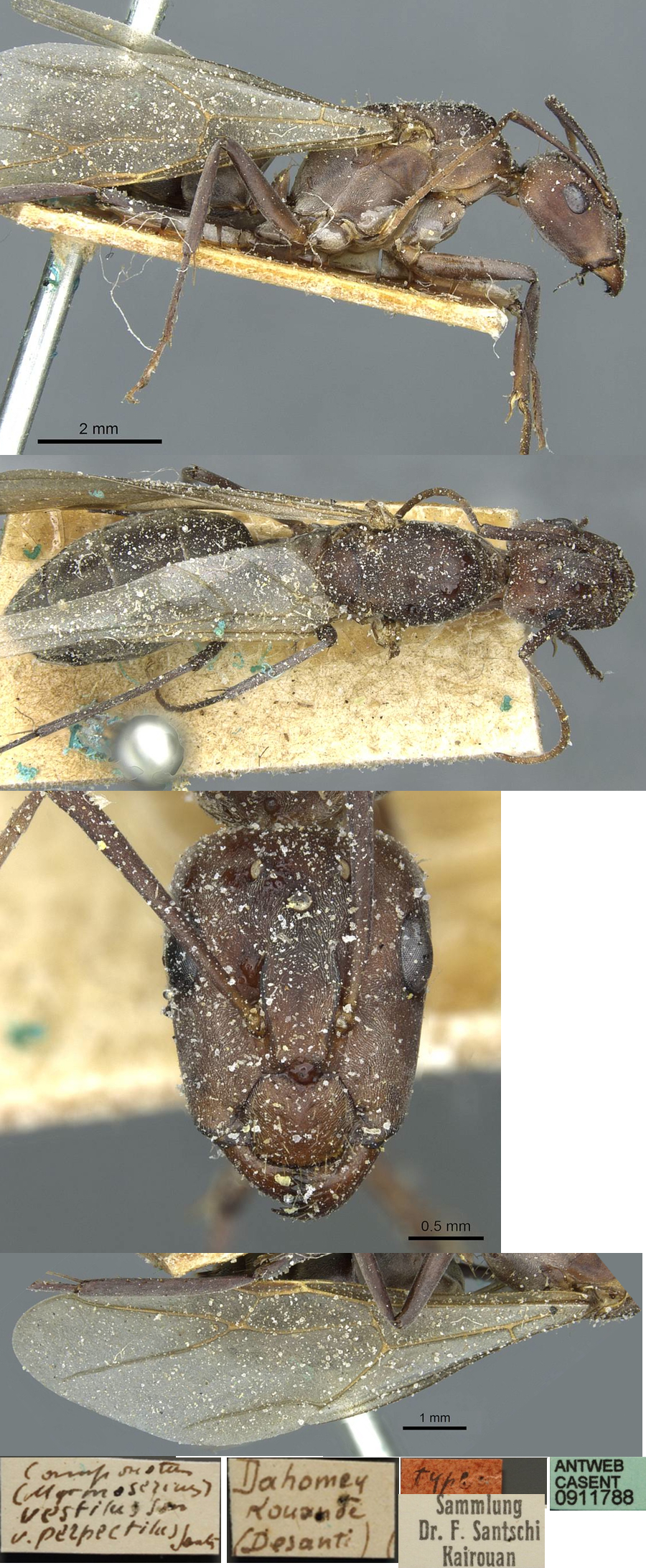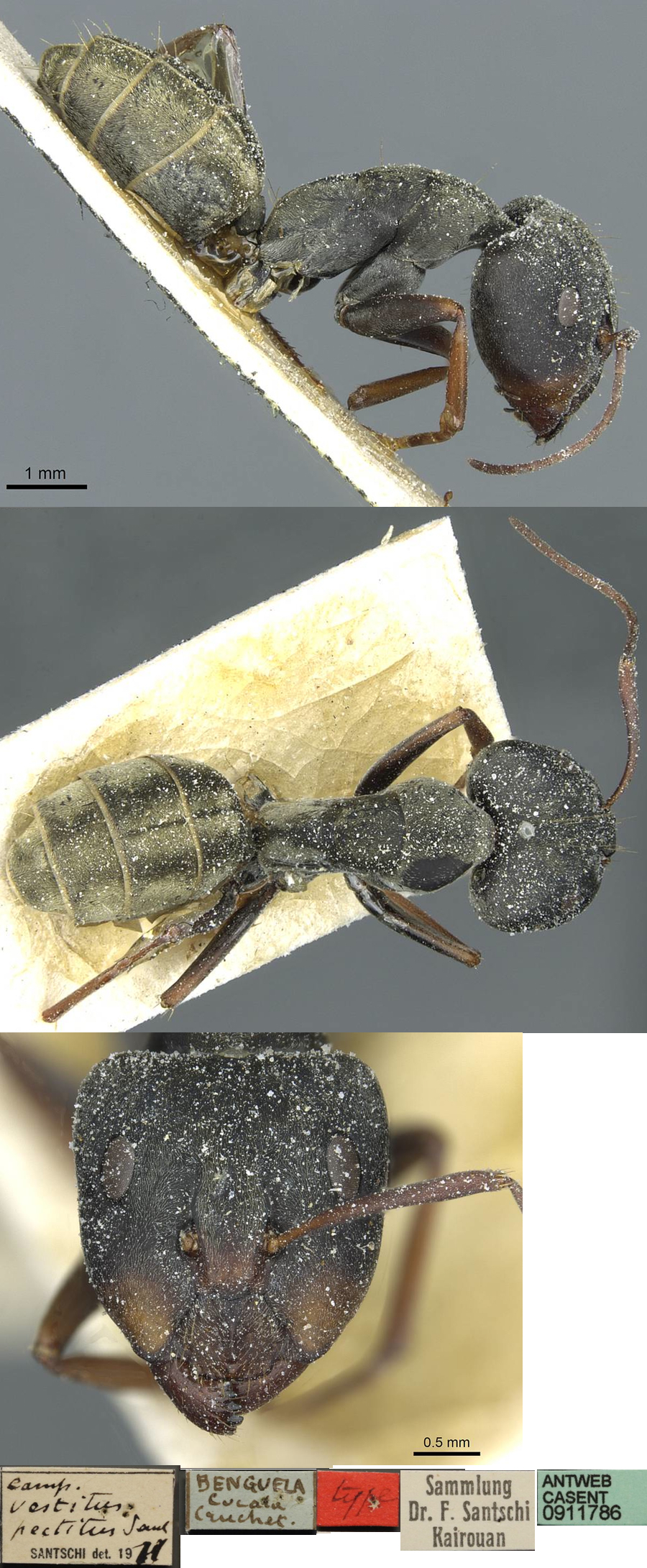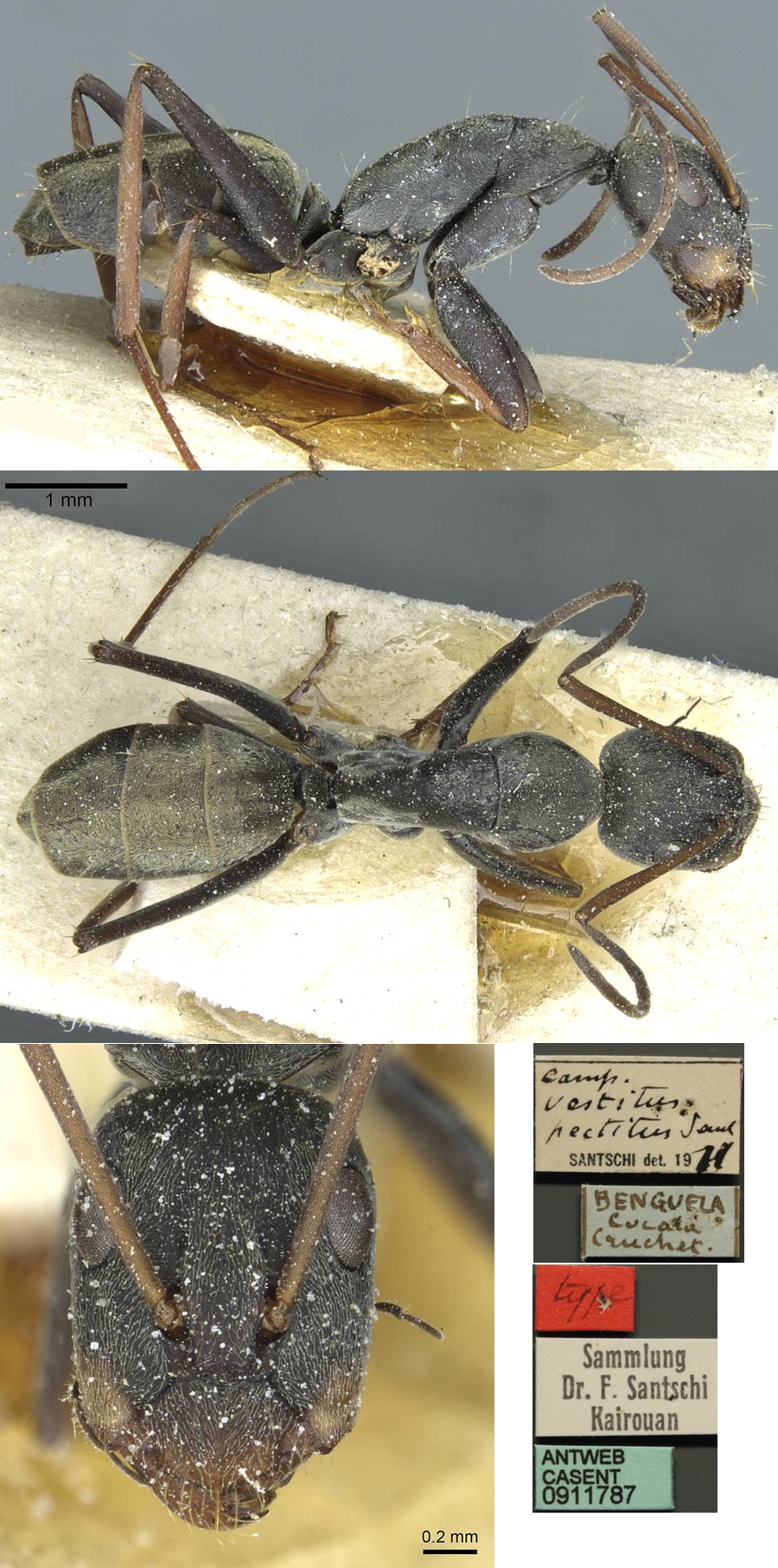Camponotus (Myrmosericus) vestitus (F. Smith)
|
NOTE: In June
2014, in correspondence over South African specimens, Christian Ludwig
drew my attention to the anomaly of the queen shown on Antweb
(photomontage below) as F Smith’s type of Formica vestita being an Anoplolepis queen. From the
illustrations, it appeared to be a very close
match to the Anoplolepis custodiens queen in
Prins (1982). Ironically, the type worker of A. custodiens came from the same
locality, Port Natal, and was described by F Smith, as “Formica custodiens” in his 1858b
paper. Now (December 2014) with fresh Anoplolepis
queen and associated workers, I have concluded that Anoplolepis vestita is
separable from A, custodiens.
But where did the Camponotus
error come from? Some taxonomic archaeology
took me back to Roger (1863b: 2) where he catalogued Smith's queen
under Camponotus but his
entry reads “27. ? vestitus Smith. Cat. Brit. Mus. 32. queen”. Jumping
on in time, the next appearance was in Emery (1894i: 113) on ants
collected in Mozambique by Cav. Fornasini and sent to Bologna, where
one
finds “Camponotus rufoglaucus
Jerdon sottosp. vestitus F.
Sm.. Una queen senza indicazione di localita”. So Emery, I conjecture,
identified a Camponotus queen
that appeared to match the general colour of Smith's description. Thus,
Emery gave firm
status to what Roger was unsure about.
Emery (1895h: 49 and
illustration) then jumped from the queen, of which there is no evidence
he saw, to the worker, with a key separation and illustration. From
that one gets the worker that I matched, from Namibia, see below.
I should have spotted the wrongness when first doing this page. My Camponotus vestitus queen from
Uganda and the
available queens of “subspecies” match.
The most senior available replacement
name for the present "Camponotus vestitus appears to be Camponotus
pectita Santschi 1911, which is the only variety of
“vestitus”
listed by Emery (1925b: 106) in his catalogue. That, however, is
complicated by the evidence of distinct groups as I discuss further
below.
|
  Listing as in Bolton (1995):
Type location South
Africa (Formica vestita, F. Smith, 1858b: 32, queen;
Arnold, 1924: 694, major and minor workers & queen) Port Natal -
the Smith (Anoplolepis queen
is shown below) but Antweb does not have images of the Arnold specimens. Listing as in Bolton (1995):
Type location South
Africa (Formica vestita, F. Smith, 1858b: 32, queen;
Arnold, 1924: 694, major and minor workers & queen) Port Natal -
the Smith (Anoplolepis queen
is shown below) but Antweb does not have images of the Arnold specimens.
subspecies
anthracinus (Camponotus (Myrmosericus) vestitus
Sm. var. anthracinus n. var., Santschi, 1930a: 74, major &
minor workers) Angola,
Benguela, J Cruchet - see below
bombycinus (Camponotus (Myrmosericus) vestitus
Sm. stirps bombycinus
n. st.,
Santschi, 1930b: 77. worker) Angola,
Chimporo - minor see http://www.antweb.org/specimenImages.do?code=casent0911782
intuens (Camponotus rufoglaucus Jerdon
subsp. cinctellus Gerst. v. intuens n. var., Forel,
1909b: 67; Santschi, 1926b: 258, worker) Angola - see below
pectitus (Camponotus rufoglaucus Jerd.
stirps vestitus Sm. v. pectita n.
var., Santschi, 1911g: 212, unavailable name; Santschi, 1930a: 74,
major & minor workers & queen) Angola, Benguela, J
Cruchet - see below
comptus (Camponotus (Myrmosericus) vestitus
Sm. v. comptus n. var., Santschi,
1926b: 259, queen; 1930a: 76, male) Ivory Coast, Dimbroko, Le
Moult - queen see below
lujai (Camponotus (Myrmosericus) vestitus Sm.
var. lujai n. var.,
Santschi, 1930a: 75, major worker & male) Zaïre, Kondué, E
Luja - see http://www.antweb.org/specimenImages.do?code=casent0911784
perpectitus (Camponotus (Myrmosericus) vestitus
Sm. v. perpectitus
n. var., Santschi, 1926b: 259, queen) Benin, Kouandé, Desanti -
see below
strophiatus (Camponotus (Myrmosericus) vestitus
Sm. v. strophiatus
n. var., Santschi, 1926b: 259, minor worker) South Africa, Cape
Town, Reichensperger - see below
major & minor workers & queen described (see Bolton, 1995)  . .
|
F Smith's (1858b) description is at  . Arnold (1924: 694) provided an expanded
description; this is at - . Arnold (1924: 694) provided an expanded
description; this is at -  . Forel's (1909b) description of intuens
is at . Forel's (1909b) description of intuens
is at  . Santschi's (1911g)
description of pectita is at . Santschi's (1911g)
description of pectita is at  . Santschi's (1926b)
descriptions of comptus, perpectitus and strophiatus
are at . Santschi's (1926b)
descriptions of comptus, perpectitus and strophiatus
are at  . Santschi's (1930a)
description of lujai and a note on vestitus are at . Santschi's (1930a)
description of lujai and a note on vestitus are at  , and his (1930a)
description of pectitus and anthracinus are at , and his (1930a)
description of pectitus and anthracinus are at  . Santschi's (1930b)
description of bombycinus is at . Santschi's (1930b)
description of bombycinus is at  . .
Forel's (1909b) description of intuens
(comparison with rufoglaucus ssp cinctellus; the latter
now being as species, Camponotus cinctellus, in its
own right, type location Mozambique) was:
TL 4.3-6; MAJOR - scape surpassing the occiput by no more than twice
its width. Head less enlarged behind. Yellow border to gastral segments
very narrow. Colour black; posterior of head, mandibles, funiculi and
legs reddish. Otherwise as cinctellus, of which it is a small
variety. Specimens from Benguela, Angola, by Creighton Wellman.
Wheeler (1922) also listed it from Cameroun (at
Mundame, by Conradt) and Zaïre (several localities but all
specimens found in the stomachs of toads).
Bernard (1952) reported this species, so common in the
plains of French West Africa, was represented in the Mt. Nimba, Guinea,
collections only by several workers from Kéoulenta and N'Zo.
Lévieux (1983a), noted its presence in Ivory Coast
savannah, at Ferkéssédougo, where it was preyed on by Myrmicaria
opaciventris (as nitidans).
|
 The photomontage
of the holotype (Anoplolepis)
queen is collated from http://www.antweb.org/specimen.do?name=casent0903234 The photomontage
of the holotype (Anoplolepis)
queen is collated from http://www.antweb.org/specimen.do?name=casent0903234
|
From the above consideration and the Antweb images now
available (posted April-May 2014) the forms listed appear to fall into
three distinct groups, as follows:
The dull red South African
form;
as described by Arnold (1924: 694), strophiatus
and
the Namibia workers shown below. Also two identical queens,
perpectitus
and comptus, both West
African; matched by the OUMNH Uganda queen.
Dark forms - comprising
the identical anthracinus, intuens, lujae and pectitus. All from Angola, other
than lujae from Zaïre, Kondué.
Entirely separate and probably unrelated is the bombycinus minor from Angola,
although listed by Santschi (1930b) as a stirps of vestitus
the label reads "C. rufoglaucus
bombycinus type Sants.".
|
Dull red forms - appearing to match the workers
described by Arnold
(1924: 694) are strophiatus
and
the Namibia workers shown below. These appear to be similar to Camponotus cosmicus but that is smaller and has a more more rounded head in full face view.
 The
photomontage
of the strophiatus type major
is collated from http://www.antweb.org/specimen.do?name=casent0911789. The
photomontage
of the strophiatus type major
is collated from http://www.antweb.org/specimen.do?name=casent0911789.
|
 The
photomontage is
of a major worker collected from Namibia,
Caprivi
Park; collectors Mann &
Marais. The
photomontage is
of a major worker collected from Namibia,
Caprivi
Park; collectors Mann &
Marais.
|
 The
photomontage is of a second major worker collected from Namibia, as above The
photomontage is of a second major worker collected from Namibia, as above
|
 The
photomontage is
of a minor worker collected from Namibia,
Caprivi
Park, as above. The
photomontage is
of a minor worker collected from Namibia,
Caprivi
Park, as above.
|
Queens - perpectitus
and comptus, matched by the
Uganda queen.
 The
photomontage
of the type perpectitus
queen
is collated from http://www.antweb.org/specimen.do?name=casent0911786.
See also the comptus queen at
http://www.antweb.org/specimenImages.do?code=casent0911783 The
photomontage
of the type perpectitus
queen
is collated from http://www.antweb.org/specimen.do?name=casent0911786.
See also the comptus queen at
http://www.antweb.org/specimenImages.do?code=casent0911783
|
 The
photomontage is of a queen collected in Uganda, Entebbe;
collector C A Wiggins; OUMNH The
photomontage is of a queen collected in Uganda, Entebbe;
collector C A Wiggins; OUMNH
|
Oxford University Museum
specimens
Camponotus (Myrmosericus) vestitus
B Taylor det. |
Namibia
D J Mann
OUMNH-2006-093
|
15.xii.1999
Caprivi Park
17°46'56" S
23°16'31" E
|
Immelmann runway, 4
km W
Dead millipede baited PF trap
coll. Mann & Marais
2 majors, 13 minors
|
15
|
 |
Camponotus (Myrmosericus) vestitus
B Taylor det. |
Botswana
King 112
|
Xakanaxa Camp
19.11.01 S
23.24.30 E
|
961 m
Forest
Nesting under log
|
1
|
 |
Camponotus (Myrmosericus) vestitus
B Taylor det.
Queen
|
Uganda
C A Wiggins
|
5.vii-7.viii.1909
Entebbe
0°02'40"N
32°27'57"E
|
ca 3800' asl
woodland by lake shore
|
1
|
 |
|
Dark forms - comprising the identical anthracinus, intuens, lujae and pectitus. Of these, the major
worker is known for pectitus.
The identical larger workers of
anthracinus (see http://www.antweb.org/specimenImages.do?code=casent0911780),
intuens (see http://www.antweb.org/specimenImages.do?code=casent0910320)
and lujae (see http://www.antweb.org/specimenImages.do?code=casent0911784)
all appear to be media workers.
 The
photomontage
of the type major of pectitus
is collated from http://www.antweb.org/specimen.do?name=casent0911786. The
photomontage
of the type major of pectitus
is collated from http://www.antweb.org/specimen.do?name=casent0911786.
|
|
 The
photomontage
of the type minor of pectitus
is collated from http://www.antweb.org/specimen.do?name=casent0911787. The
photomontage
of the type minor of pectitus
is collated from http://www.antweb.org/specimen.do?name=casent0911787.
|
It now is quite clear that the Soudano-savannah form
as shown below is quite distinct.
|
 Mike
Lush (http://sifolinia.blogspot.com/2008/03/camponotus-vestitus-cf-subsp-pectitus.html)
has written "C. cosmicus was one of the species that I checked
when I visited the London Natural History Museum, as the holotype is
there. C. cosmicus is a large and fairly stocky ant, even the
minors, unlike my specimens. I was also able to check C. vestitus
subsp. pectitus, which has all the right features (divergent
pubescence on the gaster, same number of setae on the mesosoma, same
propodeum shape) and differs only slightly in the colour of the head.
Arnold (1924) stated that Smith's (1858) description of C. cosmicus
is useless, and it appears as though he is right. However, none of the
authors who have written about C. cosmicus picked up on what I
believe is probably the most significant characteristic, as all
specimens in the museum had many erect setae on the ventral surface of
the head. I can also add that C. cosmicus is predominantly very
dark red (not black), with the propodeum rounding smoothly from the
metanotal groove, less divergent pubescence on the gaster and a greater
number of setae on the mesosoma. [See ../camponotus_cosmicus/camponotus_cosmicus.htm] Mike
Lush (http://sifolinia.blogspot.com/2008/03/camponotus-vestitus-cf-subsp-pectitus.html)
has written "C. cosmicus was one of the species that I checked
when I visited the London Natural History Museum, as the holotype is
there. C. cosmicus is a large and fairly stocky ant, even the
minors, unlike my specimens. I was also able to check C. vestitus
subsp. pectitus, which has all the right features (divergent
pubescence on the gaster, same number of setae on the mesosoma, same
propodeum shape) and differs only slightly in the colour of the head.
Arnold (1924) stated that Smith's (1858) description of C. cosmicus
is useless, and it appears as though he is right. However, none of the
authors who have written about C. cosmicus picked up on what I
believe is probably the most significant characteristic, as all
specimens in the museum had many erect setae on the ventral surface of
the head. I can also add that C. cosmicus is predominantly very
dark red (not black), with the propodeum rounding smoothly from the
metanotal groove, less divergent pubescence on the gaster and a greater
number of setae on the mesosoma. [See ../camponotus_cosmicus/camponotus_cosmicus.htm]
So, maybe it is C. vestitus subsp. pectitus.
It gets complicated because Bolton (1995) states that Santschi (1926)
suggested that C. vestitus subsp. pectitus and C.
vestitus subsp. intuens are the same, but at no point do
they appear to have been properly synonymised. Reading Santschi's
statement, it seems pretty clear that he has no doubt, so I can only
assume that Bolton did not synonymise it because the description of C.
vestitus subsp. pectitus post dates this statement! Forel's
(1909) description of C. vestitus subsp. intuens is
just as ambiguous as the descriptions of C. cosmicus and C.
vestitus subsp. pectitus.
Update Nov 2008: My specimens have now been compared
with the type specimens from the Naturhistorisches Museum Basel. This
allowed me to confirm that they are very clearly C. vestitus
subsp. intuens - a completely identical match. Possibly the
colour of the head is the key feature in discriminating these
subspecies. I also showed my specimens to Cedric Collingwood, who
claimed them to be C. jizani. This is a species from the Middle
East, though he admitted that the only reason he named it thus was
because he didn't know what else to call it! Possibly, C. jizani is
a junior synonym of C. vestitus subsp. intuens or C.
vestitus. This species was collected a number of times only in the
grounds of the hotel we were staying at in Kololi, Gambia. Here it
could be found nesting in turret nests, so named because there were
steep 'craters' of sand piled around the nest entrances, up to about an
inch high. These are described by Arnold (op. cit.) for C. vestitus
subsp. pectitus, which he states is rare and found nesting in
sandy soils. He then describes, 'nest-entrances[s] surrounded by a
circular, high and sharp-edged crater... This form of crater is
distinctive of this insect'".
|
 The photomontage
is of
a minor worker from Dakar, Senegal, collector David King. The photomontage
is of
a minor worker from Dakar, Senegal, collector David King.
|
 The photomontage is of
a minor worker from Sudan, collector Awatif Omer (Sudan 19). The photomontage is of
a minor worker from Sudan, collector Awatif Omer (Sudan 19).
|
Oxford University Museum
specimens
Camponotus (Myrmosericus) vestitus
B Taylor det. |
Senegal
David King
King 01-08
|
19.ix.2006
Dakar
14°44'48" N
17°31'35" E
|
elev 9 m asl
|
1
|
 |
Camponotus (Myrmosericus) vestitus
B Taylor det. |
Senegal
Lamine Diamé
57
|
2012
Doyene-KS
14°46'N
17°07'W
|
Sébikotane
S. saiche
tube 03
minor
|
1
|
 |
Camponotus (Myrmosericus) vestitus
B Taylor det. |
Mali
Z Yefremova & V Kravchenko
|
xii.2010
Dogon
14°21' N
03°37' W
|
Bandiagara
malaise trap
minors
|
3
|
 |
Camponotus (Myrmosericus) vestitus
B Taylor det.
|
Sudan
Awatif Omer
19
|
2012
Atbara
17°22' N
34°07' E
|
River Nile
Minor worker
? northern/sahel form
exact match for Senegal worker
|
1
|
 |
Camponotus (Myrmosericus) vestitus
B Taylor det. |
Sudan
Awatif Omer
2013.02.01
|
2013
Abu Hijar
12˚52' N
34˚0' E
|
minor workers
|
2
|
 |
Camponotus (Myrmosericus) vestitus
B Taylor det. |
Sudan
Awatif Omer
2013.02.11
|
2013
Abu Hijar
12˚52' N
34˚0' E
|
minor workers
|
1
|
 |
Camponotus (Myrmosericus) vestitus
B Taylor det. |
Sudan
Awatif Omer
2013.02.15
|
2013
Sinja
13˚09' N
33˚55'60" E
|
minor workers
|
1
|
 |
Camponotus (Myrmosericus) vestitus
B Taylor det. |
Sudan
Awatif Omer
2013.02.22
|
2013
Abu Hijar
12˚52' N
34˚0' E
|
minor workers
|
1
|
 |
Camponotus (Myrmosericus) vestitus
B Taylor det. |
Sudan
Awatif Omer
2013.02.27
|
2013
Abu Hijar
12˚52' N
34˚0' E
|
minor workers
|
2
|
 |
|
|